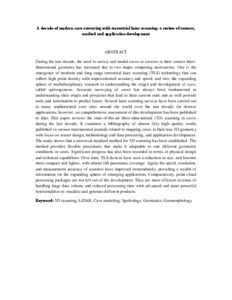Citation
Idrees, Mohammed Oludare and Pradhan, Biswajeet
(2016)
A decade of modern cave surveying with terrestrial laser scanning: a review of sensors, method and application development.
International Journal of Speleology, 45 (1).
pp. 71-88.
ISSN 0392-6672; ESSN: 1827-806X
Abstract
During the last decade, the need to survey and model caves or caverns in their correct three-dimensional geometry has increased due to two major competing motivations. One is the emergence of medium and long range terrestrial laser scanning (TLS) technology that can collect high point density with unprecedented accuracy and speed, and two, the expanding sphere of multidisciplinary research in understanding the origin and development of cave, called speleogenesis. Accurate surveying of caves has always been fundamental to understanding their origin and processes that lead to their current state and as well provide tools and information to predict future. Several laser scanning surveys have been carried out in many sophisticated cave sites around the world over the last decade for diverse applications; however, no comprehensive assessment of this development has been published to date. This paper reviews the state-of-the-art three-dimensional (3D) scanning in caves during the last decade. It examines a bibliography of almost fifty high quality works published in various international journals related to mapping caves in their true 3D geometry with focus on sensor design, methodology and data processing, and application development. The study shows that a universal standard method for 3D scanning has been established. The method provides flexible procedures that make it adaptable to suit different geometric conditions in caves. Significant progress has also been recorded in terms of physical design and technical capabilities. Over time, TLS devices have seen a reduction in size, and become more compact and lighter, with almost full panoramic coverage. Again, the speed, resolution, and measurement accuracy of scanners have improved tremendously, providing a wealth of information for the expanding sphere of emerging applications. Comparatively, point cloud processing packages are not left out of the development. They are more efficient in terms of handling large data volume and reduced processing time with advanced and more powerful functionalities to visualize and generate different products.
Download File
![[img]](http://psasir.upm.edu.my/60598/1.hassmallThumbnailVersion/A%20decade%20of%20modern%20cave%20surveying%20with%20terrestrial%20laser%20scanning%20a%20review%20of%20sensors%2C%20method%20and%20application%20development.pdf)  Preview |
|
Text (Abstract)
A decade of modern cave surveying with terrestrial laser scanning a review of sensors, method and application development.pdf
Download (37kB)
| Preview
|
|
Additional Metadata
Actions (login required)
 |
View Item |

